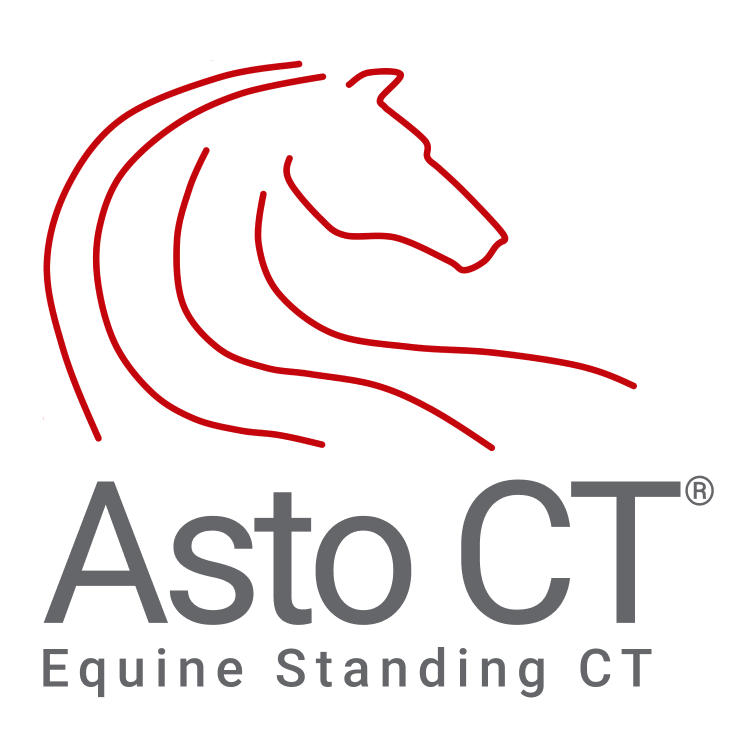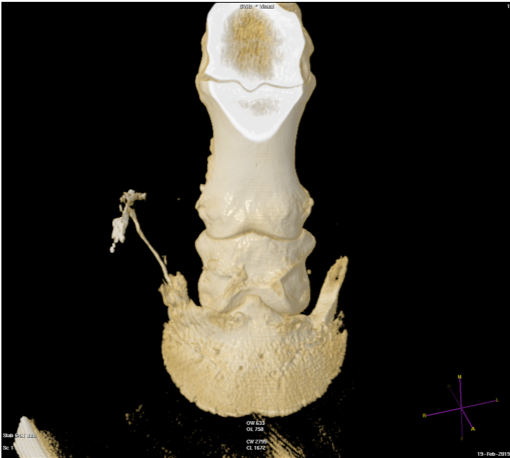
THE EQUINA® BY ASTO CT
BUILT FROM THE GROUND UP, THE EQUINA IS THE WORLD’S ONLY TRUE WEIGHT-BEARING, FAN-BEAM CT SCANNER WHICH ALLOWS FOR SCANNING IN A NATURAL STANDING POSITION.

HI, MY NAME IS ROMAN
Roman is a Shire gelding who currently shows at the top-level circuits. His owner made the decision to bring him to the clinic due to a persistent draining tract and emerging complications within his right front foot.
CLINICAL EXAMINATION
Roman was initially treated surgically for quittor, an infection of the collateral cartilage on the lateral side of the foot. Surgery went well, and he went home to continue healing. A couple months later he returned to the clinic for a persistent draining tract. Subsequently he was recommended for a CT scan to further investigate.
CT FINDINGS - FISTULA WITH SEQUESTRUM
CT images show a draining tract just proximal to the coronary band on the lateral aspect of the foot. Clinicians performed a fistulogram on the horse in the CT suite. They were able to determine the draining tract (fistula) communicated all the way down to the coffin bone where there was a suspected bone sequestrum.
WHAT IS A FISTULA AND SEQUESTRUM?
A fistula is an abnormal tunnel-like tract that connects between the bone sequestrum and the skin in this case. Reason being the body is trying to expel the dead piece of bone with surrounding infection and creates a fistula to do so.
A bone sequestrum in a horse is a piece of dead bone that has separated from the healthy bone. A bone sequestrum that is infected can delay the healing process and it will continue to drain and cause pain until it is removed.
SURGERY
Roman was able to remain standing on top of the CT scanner throughout the entire procedure. The picture shows a cannula that was placed in the draining tract, where contrast was administered. The team successfully debrided the bone sequestrum under CT guidance. Roman is now doing much better at home.
WHY IS CT USEFUL?
Interoperative imaging using the Equina standing CT scanner is particularly useful in cases where standing surgery is an option. CT imaging can be used to create 3D reconstructions of the affected area, which can be incredibly helpful in planning surgical procedures or interventions. These reconstructions allow the veterinarian to assess the sequestrum's relationship to other structures and plan the best approach, minimize damage to healthy tissues, and increase the chances of successful removal.
CT Video: Shows the draining tract (fistula) communicating all the way down to the coffin bone.
Find Out More About The Equina® CT Scanner
CLICK THE ICONS BELOW
A WORD FROM OUR SUPPORTIVE EQUINE VETERINARIANS

Stay in the loop with Asto CT













